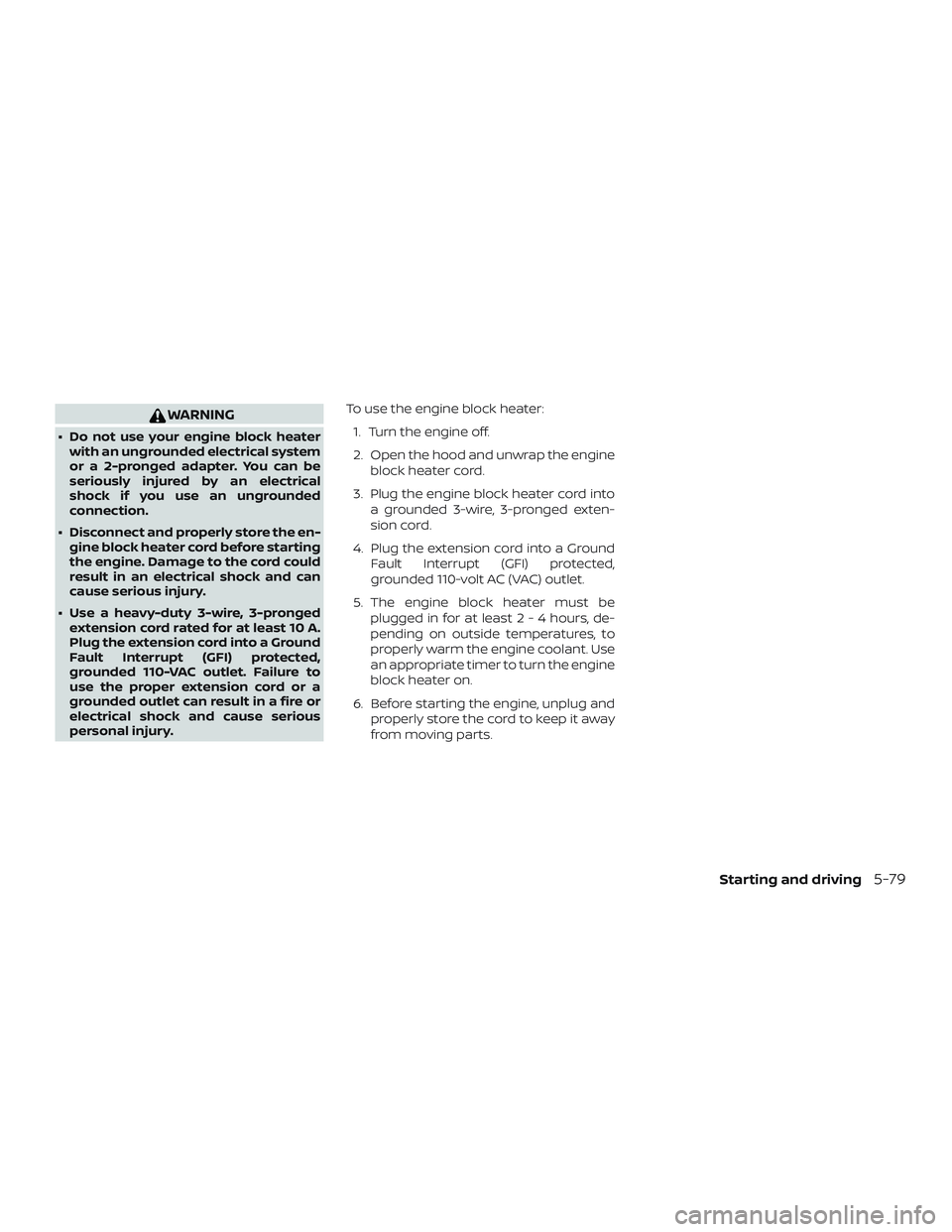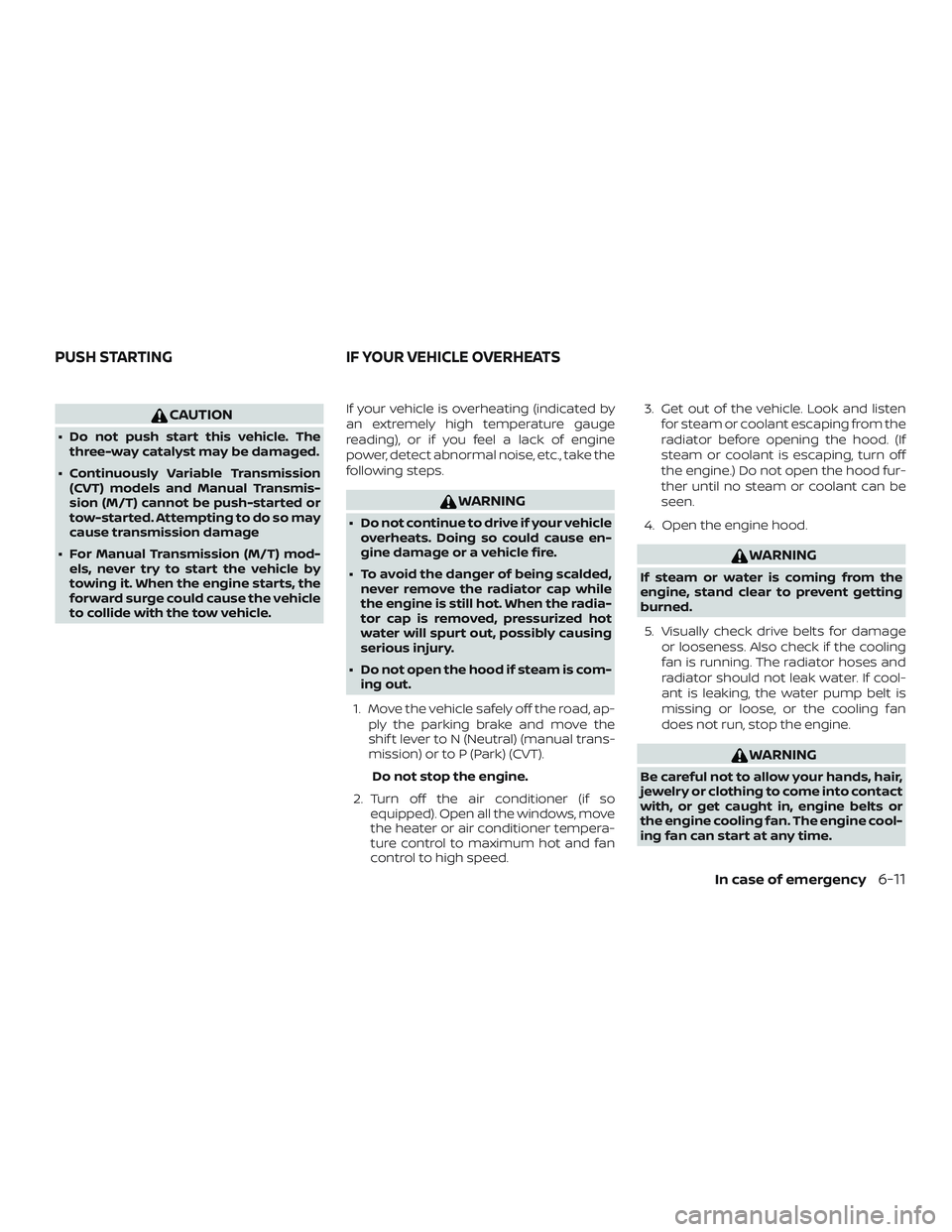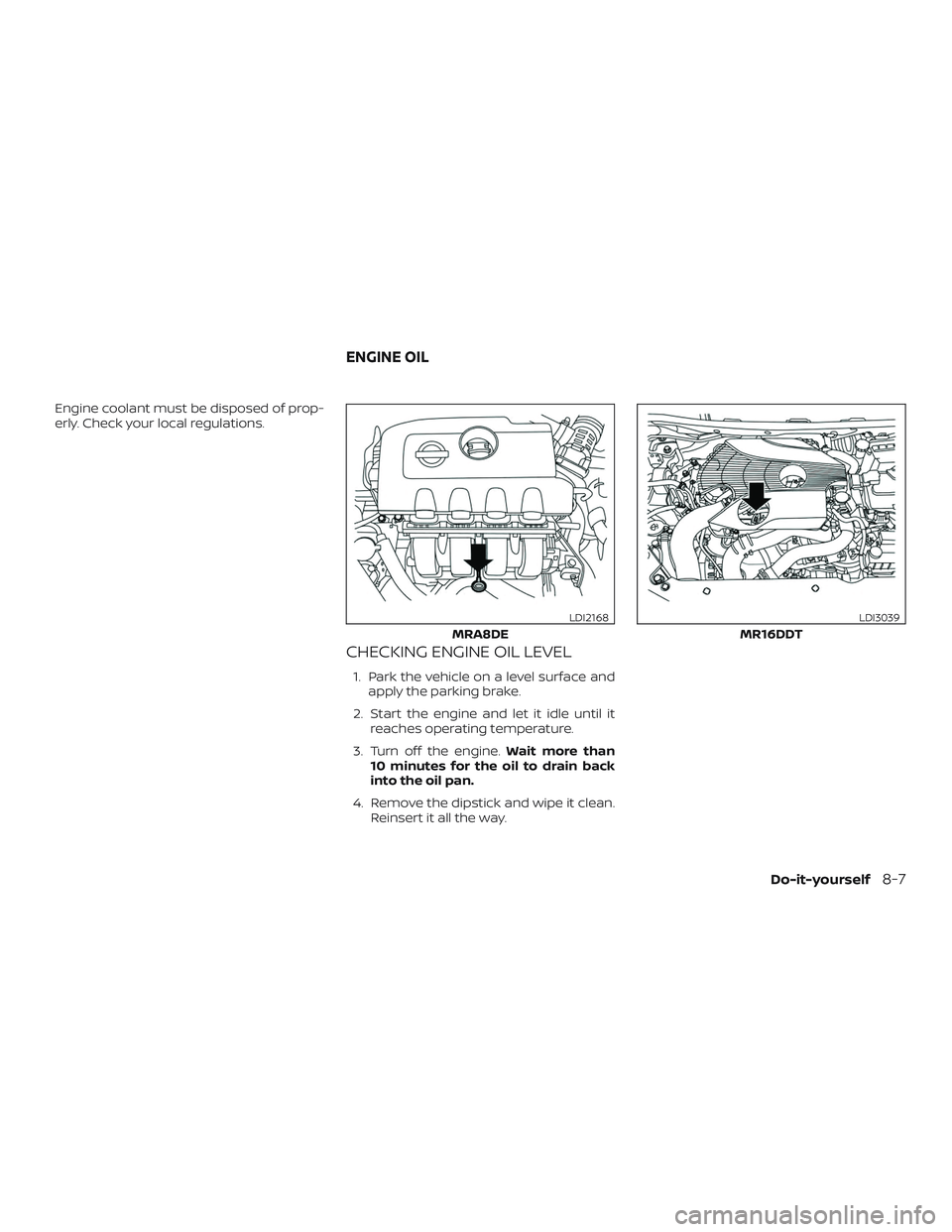2018 NISSAN SENTRA coolant temperature
[x] Cancel search: coolant temperaturePage 385 of 507

WARNING
∙ Do not use your engine block heaterwith an ungrounded electrical system
or a 2-pronged adapter. You can be
seriously injured by an electrical
shock if you use an ungrounded
connection.
∙ Disconnect and properly store the en- gine block heater cord before starting
the engine. Damage to the cord could
result in an electrical shock and can
cause serious injury.
∙ Use a heavy-duty 3-wire, 3-pronged extension cord rated for at least 10 A.
Plug the extension cord into a Ground
Fault Interrupt (GFI) protected,
grounded 110-VAC outlet. Failure to
use the proper extension cord or a
grounded outlet can result in a fire or
electrical shock and cause serious
personal injury. To use the engine block heater:
1. Turn the engine off.
2. Open the hood and unwrap the engine block heater cord.
3. Plug the engine block heater cord into a grounded 3-wire, 3-pronged exten-
sion cord.
4. Plug the extension cord into a Ground Fault Interrupt (GFI) protected,
grounded 110-volt AC (VAC) outlet.
5. The engine block heater must be plugged in for at least2-4hours, de-
pending on outside temperatures, to
properly warm the engine coolant. Use
an appropriate timer to turn the engine
block heater on.
6. Before starting the engine, unplug and properly store the cord to keep it away
from moving parts.
Starting and driving5-79
Page 397 of 507

CAUTION
∙ Do not push start this vehicle. Thethree-way catalyst may be damaged.
∙ Continuously Variable Transmission (CVT) models and Manual Transmis-
sion (M/T) cannot be push-started or
tow-started. Attempting to do so may
cause transmission damage
∙ For Manual Transmission (M/T) mod- els, never try to start the vehicle by
towing it. When the engine starts, the
forward surge could cause the vehicle
to collide with the tow vehicle. If your vehicle is overheating (indicated by
an extremely high temperature gauge
reading), or if you feel a lack of engine
power, detect abnormal noise, etc., take the
following steps.
WARNING
∙ Do not continue to drive if your vehicle
overheats. Doing so could cause en-
gine damage or a vehicle fire.
∙ To avoid the danger of being scalded, never remove the radiator cap while
the engine is still hot. When the radia-
tor cap is removed, pressurized hot
water will spurt out, possibly causing
serious injury.
∙ Do not open the hood if steam is com- ing out.
1. Move the vehicle safely off the road, ap- ply the parking brake and move the
shif t lever to N (Neutral) (manual trans-
mission) or to P (Park) (CVT).
Do not stop the engine.
2. Turn off the air conditioner (if so equipped). Open all the windows, move
the heater or air conditioner tempera-
ture control to maximum hot and fan
control to high speed. 3. Get out of the vehicle. Look and listen
for steam or coolant escaping from the
radiator before opening the hood. (If
steam or coolant is escaping, turn off
the engine.) Do not open the hood fur-
ther until no steam or coolant can be
seen.
4. Open the engine hood.
WARNING
If steam or water is coming from the
engine, stand clear to prevent getting
burned.
5. Visually check drive belts for damage or looseness. Also check if the cooling
fan is running. The radiator hoses and
radiator should not leak water. If cool-
ant is leaking, the water pump belt is
missing or loose, or the cooling fan
does not run, stop the engine.
WARNING
Be careful not to allow your hands, hair,
jewelry or clothing to come into contact
with, or get caught in, engine belts or
the engine cooling fan. The engine cool-
ing fan can start at any time.
PUSH STARTING IF YOUR VEHICLE OVERHEATS
In case of emergency6-11
Page 419 of 507

Engine coolant must be disposed of prop-
erly. Check your local regulations.
CHECKING ENGINE OIL LEVEL
1. Park the vehicle on a level surface andapply the parking brake.
2. Start the engine and let it idle until it reaches operating temperature.
3. Turn off the engine. Wait more than
10 minutes for the oil to drain back
into the oil pan.
4. Remove the dipstick and wipe it clean. Reinsert it all the way.
MRA8DE
LDI2168
MR16DDT
LDI3039
ENGINE OIL
Do-it-yourself8-7
Page 498 of 507

Brakewarninglight............2-14
Brakewearindicators.......2-22,8-21
Self-adjustingbrakes...........8-21
Brakeandclutchfluid.............8-12
Brake assist ...................5-74
Brakefluid....................8-12
Brakes......................8-21
Brake system ..................5-72
Break-in schedule ...............5-68
Brightness/contrast button .........4-9
Brightness control Instrument panel .............2-45
Bulb check/instrument panel ........2-14
Bulb replacement ...............8-33
C
Capacities and recommended fuel/
lubricants....................10-2
Cargo
(See vehicle loading information) .....10-14
Car phone or CB radio ............4-79
CDcareandcleaning.............4-71
CD player
(See audio system) ........4-46,4-51,4-58
Check tire press .................2-6
Check tire pressure ..............2-34
Childrestraints........1-21, 1-22, 1-23, 1-26 LATCH (Lower Anchors and Tethers for
CHildren)System..............1-26
Precautions on child
restraints .........1-23, 1-30, 1-36, 1-41
Top tether strap anchor point
locations.................. .1-28
Child safety rear door lock ..........3-7Chimes, audible reminders
.........2-22
Cleaningexteriorandinterior......7-2,7-4
Clock
(models without navigation system). .4-50
Clockset ....................4-50
Clock set/adjustment .............4-7
Clock setting (models with Navigation
System)......................4-7
Clock setting (models without Navigation
System)...........4-44,4-45,4-49,4-50
Clutch Clutchfluid.................8-12
C.M.V.S.S. certification label .........10-12
Cold weather driving .............5-77
Compact disc (CD) player . . .4-46, 4-51, 4-58
Connect phone ................4-74
Console box ..................2-53
Console light ..................2-61
Continuously Variable Transmission
(CVT) .....................5-9,5-17
Continuously Variable Transmission
(CVT) fluid ..................8-11
Driving with Continuously Variable
Transmission (CVT) ..........5-9,5-17
Control panel buttons .............4-4
Back button .................4-7
Brightness/contrast button .......4-9
Enterbutton.................4-4
Settingbutton................4-7
Controls Audio controls (steering wheel) .....4-72
Heater and air conditioner
controls................4-24,4-32
Coolant Capacities and recommended
fuel/lubricants...............10-2 Changing engine coolant
.........8-6
Checking engine coolant level ......8-6
Engine coolant temperature gauge. . .2-7
Corrosionprotection..............7-8
Cruisecontrol.................5-45
Cupholders...................2-55
Curtain side-impact air bag system
(See supplemental side air bag and curtain
side-impact air bag system) ........1-59
D
Daytime Running Light System ......2-44
Defroster switch Rear window and outside mirror
defrosterswitch..............2-40
Dimensions and weights ..........10-10
Dimmer switch for instrument panel . . .2-45
Display controls
(see control panel buttons) ..........4-4
Door locks ....................3-5
Door open warning light ...........2-15
Drivebelt ....................8-16
Driving Coldweatherdriving...........5-77
Driving with Continuously Variable
Transmission (CVT) ..........5-9,5-17
Driving with manual
transmission .............5-10,5-23
Precautions when starting and
driving .....................5-2
Driving the vehicle ...............5-17
11-2
Page 499 of 507

E
E-CALL (SOS) SWITCH .............2-49
ECO mode switch ...............5-26
Economy - fuel .................5-70
Emergency engine shutoff ..........5-13
Emission control information label . . . .10-12
Emission control system warranty . . . .10-19
Engine Before starting the engine ........5-14
Capacities and recommended
fuel/lubricants...............10-2
Changing engine coolant .........8-6
Changing engine oil ............8-8
Changing engine oil filter .........8-10
Checking engine coolant level ......8-6
Checking engine oil level .........8-7
Engine compartment check
locations...................8-3
Engine coolant temperature gauge. . .2-7
Engine cooling system ..........8-5
Engine oil ...................8-7
Engine oil and oil filter
recommendation .............10-7
Engine oil pressure warning light ....2-15
Engine oil viscosity .............10-7
Engine serial number ..........10-12
Engine specifications ...........10-9
Starting the engine ............5-15
Engine Block Heater .............5-78
Engine coolant temperature gauge .....2-7
Enterbutton...................4-4
EventDatarecorders ............10-21
Exhaust gas (Carbon monoxide) .......5-2
Explanation of maintenance items .....9-2Explanation of scheduled maintenance
items .......................9-5
Extended storage switch
..........8-25
Eyeglasscase.................2-54
F
Flashers
(See hazard warning flasher switch) ....6-2
Flattire....................6-3,6-3
Floormatpositioningaid...........7-7
Fluid Brakefluid..................8-12
Capacities and recommended
fuel/lubricants...............10-2
Clutchfluid.................8-12
Continuously Variable Transmission (CVT)
fluid......................8-11
Engine coolant ...............8-5
Engine oil ...................8-7
F.M.V.S.S. certification label .........10-12
Foglightswitch................2-46
Front air bag system
(See supplemental restraint system) . . . .1-51
Front-door pocket ..............2-50
Front power seat adjustment ........1-5
Frontseats....................1-2
Fuel Capacities and recommended
fuel/lubricants...............10-2
Fuel economy ...............5-70
Fuel-filler cap ................3-28
Fuel-filler door lock opener lever ....3-27
Fuel-filler lid .................3-28
Fuel gauge ..................2-8 Fueloctanerating.............10-6
Fuel recommendation
..........10-4
Loose fuel cap warning .......2-6, 2-33
Fuelefficientdrivingtips...........5-68
Fuel-filler door .................3-27
Fuel gauge ....................2-8
Fuses.......................8-22
Fusiblelinks...................8-23
G
Gar
age door opener, HomeLink® Universal
Transceiver . .2-63, 2-64, 2-65, 2-66, 2-66, 2-67
Gascap.....................3-28
Gauge Engine coolant temperature gauge. . .2-7
Fuel gauge ..................2-8
Odometer ..................2-5
Speedometer ..............2-4,2-5
Tachometer .................2-7
Trip computer ................2-9
Trip odometer .............2-4, 2-5
General maintenance .............9-2
Glovebox................... .2-53
H
Hands-free phone system, Bluetooth® . .4-79
Hazardwarningflasherswitch........6-2
Headlight and turn signal switch ......2-41
Headlightcontrolswitch...........2-41
Headlights ...................8-29
Headrestraints..................1-7
Heatedseats..................2-47
11-3
Page 503 of 507

StartingBefore starting the engine ........5-14
Jumpstarting.............6-9,8-15
Precautions when starting and
driving.....................5-2
Push starting ................6-11
Starting the engine ............5-15
Starting the engine ..............5-15
Starting the engine (models with NISSAN
Intelligent Key® system) ...........5-16
Steering Power steering system ..........5-71
Steering wheel .................3-30
Steering wheel audio control switch . . .4-72
Stoplight....................8-33
Storage.....................2-50
Storagetray ..................2-52
Sunglasses case ................2-54
Sunglasses holder ..............2-54
Sunroof .....................2-59
Sunroof (see Moonroof ) ...........2-59
Sunvisors....................3-30
Supplemental air bag warning labels . . .1-62
Supplemental air bag warning
light.................... .1-63, 2-19
Supplemental front impact air bag
system ..................... .1-51
Supplemental restraint system Information and warning labels . . . .1-62
Precautions on supplemental restraint
system ....................1-44
Supplemental restraint system
(Supplemental air bag system) .......1-44
Supplemental side and curtain side-impact
airbagsystem................ .1-59Switch
Autolightswitch..............2-42
Automatic power window switch . . .2-58
Foglightswitch..............2-46
Hazard warning flasher switch ......6-2
Headlight and turn signal switch ....2-41
Headlightcontrolswitch.........2-41
Ignition switch ................5-9
Instrument brightness control .....2-45
Power door lock switch ..........3-6
Rear window and outside mirror
defrosterswitch..............2-40
Turn signal switch .............2-45
T
Tachometer ...................2-7
Temperature gauge Engine coolant temperature gauge. . .2-7
Thef t (NISSAN Vehicle Immobilizer System),
engine start ............2-38,5 -11, 5-14
Three-waycatalyst...............5-2
Tilt Telescopicsteering............3-30
Tire Flattire..................6-3,6-3
Spare tire ...............6-4,8-46
Tire and Loading Information label . .10-13
Tire chains .................8-42
Tire pressure ................8-35
Tirerotation ................8-43
Types of tires ................8-41
Uniform tire quality grading ......10-18
Wheels and tires ..............8-35
Wheel/tire size ...............10-10 Tire pressure
Lowtirepressurewarninglight.....2-16
Tire Pressure Monitoring System
(TPMS)....................2-6,5-3
Towing 2-wheel drive models ...........6-14
4-wheel drive models ...........6-13
Flattowing.................10-18
Trailertowing...............10-18
Towingatrailer................10-18
Towingyourvehicle..............6-12
Transceiver HomeLink® Universal Transceiver . . .2-63, 2-64, 2-65, 2-66, 2-66, 2-67
Transmission Continuously Variable Transmission (CVT)
fluid......................8-11
Driving with Continuously Variable
Transmission (CVT) ..........5-9,5-17
Driving with manual
transmission.............5-10, 5-23
Travel (See registering a vehicle in another
country) .....................10-11
Trip computer ..................2-9
Trip odometer ...............2-4,2-5
T
roubleshooting guide
(NISSAN voice recognition system) ....4-106
Trunk access through the rear seat ....3-27
Trunklid.....................3-26
Trunk lid lock opener lever ..........3-26
Trunklight....................2-63
Turn signal switch ...............2-45
11-7